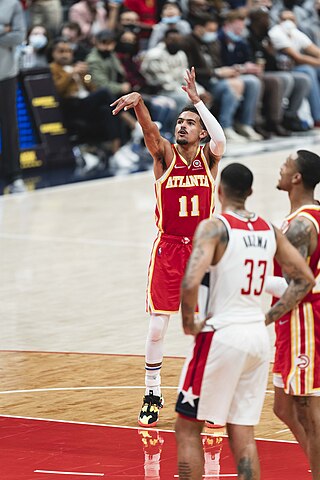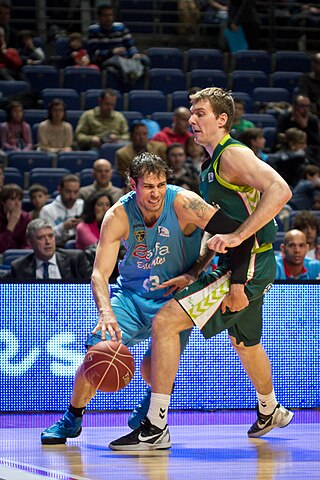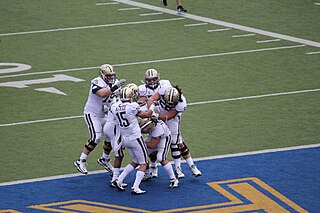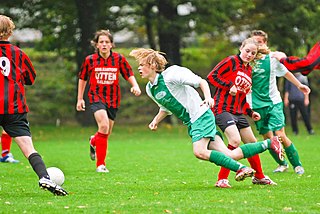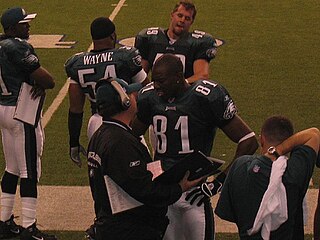Examples in different sports
In American football, unsportsmanlike conduct results in a 15-yard penalty, assessed after the completion of a play. [1] When it occurs after a scoring play, the 15 yards are assessed on the kickoff. Situations that can incur such a penalty include excessive celebrations after plays, often involving props or multiple players or engaging in taunting against an opponent; a player's purposeful removal of his helmet anywhere in the field of play during or in between plays; or if a substitute leaves the team bench during a fight. Unsportsmanlike conduct can also lead to players or coaches being ejected from the game if the conduct is found to be flagrant, such as making contact with game officials. In the NCAA, two unsportsmanlike conduct fouls lead to the offender's ejection. Two unsportsmanlike conduct fouls may lead to the offender's ejection in the NFL, depending on the nature of each foul (a rule first implemented for the 2016 season after the events of the previous season's clash between New York Giants receiver Odell Beckham Jr and Carolina Panthers defensive back Josh Norman). [2]
The referee signals unsportsmanlike conduct by holding his arms outstretched with palms facing downward. Coaches can also receive an unsportsmanlike-conduct penalty for taunting, arguing with, or abusing officials, one of the few times a coach's actions can be penalized outside of the rare palpably unfair act penalty; however, unlike the players, coaches cannot be disqualified for their second. [3]
During the COVID-19 pandemic in the United States, the definition of unsportsmanlike conduct was expanded to include violating protocols designed to curb the spread of COVID-19. Penalties may include fines, suspensions, or even loss of draft picks [4] in addition to the standard 15-yard penalty for the guilty party. [5]
In Canadian football, unsportsmanlike conduct is covered by two penalties. Nonviolent offenses constitute an objectionable conduct foul and only carries a 10-yard penalty. (Indoor American football leagues, because of the shorter field, also assign a 10-yard penalty for unsportsmanlike conduct.) Rough play is the foul called for unsportsmanlike violent behavior; it carries a 25-yard penalty, the largest in all gridiron football.
In association football, the term "unsporting behaviour" is more commonly used, being one of the listed reasons under law 12 of the laws of the game for which a yellow card may be given. It is interpreted broadly, most commonly to sanction fouls which are more serious than most, though below a level which would merit a red card. [6] Other examples include extravagant goal celebrations (e.g. removing one's jersey) and simulating actions intended to deceive the referee (diving).
In basketball, such misconduct is penalized by a technical foul as opposed to a personal foul. The technical foul is akin to a caution in that two such fouls warrant an expulsion, although egregious conduct will be immediately assessed two consecutive technical fouls, or in at least one case, one.
In tennis, such conduct is categorized as a "code violation". Examples include racket abuse (intentionally throwing a racket or using it to strike an object other than the ball), ball abuse (intentionally hitting or throwing the ball into the stands outside of normal play), or intentionally shouting during a point in order to distract an opponent. Penalties vary based on the organizers of the match or tournament and usually start with a verbal warning for a first violation, and forfeiture of a point, game, or a match for additional violations.
In cricket, such behaviour is considered to be violating the "spirit of the game". The preamble to the Laws of Cricket [7] state certain actions which may violate the spirit of cricket. A more detailed list (along with appropriate sanctions) is given in the ICC Cricket Code of Conduct. Since good behaviour in cricket is traditionally deemed the sine qua non of a gentleman to the game's historical status as a "gentleman's game", it has led to the saying "It's not cricket", an English language phrase meaning unsportsmanlike conduct in sports, in business, or in life in general. There is considerable debate over whether sledging should be deemed as "unsportsmanlike behaviour" and banned due to several high profile punishable instances of racial and verbal abuse during international matches; proponents have argued that sledging was meant to be witty and humorous and not a personal attack on the opposition player. [8] [9] [10] In-game punishments for offences are not substantial and often limited to a handful of penalty runs, but can have much wider consequences as the umpires call into question the honour, integrity and honesty of the player. This can cause significant recriminations from players & nations accused. An example of which was the 2006 ball-tampering controversy, where two umpires judged that Pakistan had been ball tampering and awarded 5 penalty runs to England. Pakistan refused to take the field after a break in play, causing a forfeit win to be given to England and a huge scandal within the sport.
In ice hockey, unsportsmanlike conduct is defined in Rule 75 of the National Hockey League and IIHF Rule Book [11] [12] both read as follows: "Players, goalkeepers and non-playing Club personnel are responsible for their conduct at all times and must endeavor to prevent disorderly conduct before, during or after the game, on or off the ice and any place in the rink. The Referees may assess penalties to any of the above team personnel for failure to do so." A player can receive a two-minute penalty for unsportsmanlike conduct. Unusually for a team sport, fighting, in most circumstances, does not constitute unsportsmanlike conduct. Referees signal the penalty by making a "T" shape with their hands; palm to finger tips. This leads to it being referred to as being "T'd off".
In fighting sports such as boxing, unsportsmanlike conduct such as low blows or elbowing can result in a competitor losing a match by disqualification. [13]
Field lacrosse
Field lacrosse's definition of unsportsmanlike conduct generally includes the same behavior as other sports, such as arguing with the official over a call, using foul language , using the lacrosse stick as a weapon for attacking players and/or nonplaying personnel,and fans,taunting or baiting other players. It is considered a personal foul under the rules. Coaches and nonplaying personnel can incur the penalty if they enter the field without the official's permission (save situations where the rules allow it) or use abusive language toward officials. Additional infractions can be called if the behavior continues. Penalties can vary from one to three minutes, usually non-releasable; in some less severe instances that do not involve abusive conduct, such as deliberately handling the ball during play, repeatedly committing the same technical foul or deliberately delaying return to the playing field in order to gain an advantage, those penalties are releasable. [14]
Under rules for high school boys/girls' lacrosse, a second unreleasable unsportsmanlike conduct penalty against the same player is an automatic ejection foul. The player must serve three unreleasable minutes in the penalty area; when that time expires, a substitute must re-enter the game in his place. (S)he must leave the game area unless they are no school personnel around to supervise, in which case (s)he is confined to the bench area for the rest of the game, plus his/her suspension increasing by a game. [15]




